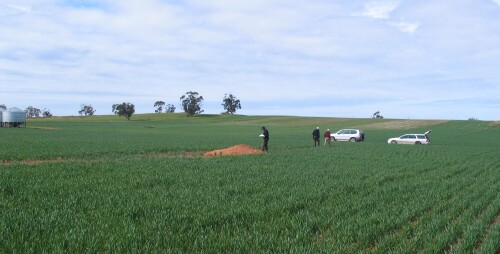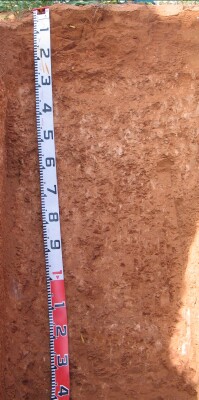NTF7
| Location: Carwarp, Victoria | Landform: Dune |
| Geology: Quaternary Woorinen Formation: aeolian dune sand, calcareous clay | Element: Dune Swale |
| Slope: 2% | Aspect: 200o |
 NTF7 landscape |
Soil Profile Morphology:
Surface Soil
| 1A11 | 0–8 cm | Yellowish red (5YR4/6) sandy loam; apedal massive structure; dry water status; weak consistence; moderately calcareous; pH 8.0; few fine to very fine roots; abrupt smooth boundary to: |  NTF7 profile |
| 2A12 | 8–25 cm | Yellowish red (5YR4/6) sandy clay loam; apedal massive structure; dry water status; firm consistence; highly calcareous; pH 8.5; few fine to very fine roots; abrupt smooth boundary to: | |
| Subsoil | |||
| 2B21k | 25–55 cm | Yellowish red (5YR5/8) many coarse prominent reddish yellow mottles; light medium clay; moderate subangular blocky structure; peds 5-20 mm; rough fabric; dry water status; firm consistence; moderately cemented continuous nodular calcrete pan; medium to course calcareous nodules and medium to course calcareous soft segregations are common; very highly calcareous; pH 9.0; few fine to very fine roots; gradual boundary to: | |
| 2B22k | 55–115 cm | Yellowish red (5YR5/8) few medium size distinct reddish brown mottles; medium clay; strong prismatic structure; peds 5-20 mm as well as strong angular blocky structure; peds 2-5 mm; smooth fabric; few distinct clay skin cutans; moderately moist water status; strong consistence; moderately cemented continuous nodular calcrete pan; very few medium size calcareous nodules and few medium size calcareous soft segregation's as well as few coarse argillaceous tubules; very highly calcareous; pH 9.5; gradual boundary to: | |
| 3B/D1 | 115–140 cm | Yellowish red (5YR5/8) many coarse prominent red mottles; medium clay; strong angular blocky structure; peds 10-20 mm; as well as strong subangular blocky structure; peds 2-10 mm; smooth fabric; few distinct clay skin cutans; dry water status; very firm to strong consistence; moderately cemented continuous nodular calcrete pan; many medium to course calcareous nodules and many course calcareous soft segregation's as well as very few fine manganiferous fragments; very highly calcareous; pH 9.5; gradual boundary to: | |
Key Profile Features:
Soil Profile Characteristics:
Horizon | Horizon Depth (cm) | pH (water) | pH (CaCl2) | EC 1:5 | NaCI % | Exchangeable Cations | Field Capacity pF 2.5 | Wilting Point pF 4.2 | Coarse Sand (0.2 - 2 mm) | Fine Sand (0.02 -0.2 mm) | Silt (0.002 -0.02 mm) | Clay (<0.002 mm) | |||
Ca | Mg | K | Na | ||||||||||||
meq/100g | |||||||||||||||
1A11 | 0–8 | 8.7 | 8.1 | 0.1 | 16 | 1.7 | 1.2 | 0.09 | 23.1 | 8.7 | 46.2 | 35.3 | 4.5 | 12.5 | |
2A12 | 8–25 | 8.8 | 8.2 | 0.11 | 21 | 4.2 | 1.6 | 0.15 | 19.6 | 8.1 | 37.7 | 15.5 | 13 | 27.6 | |
2B21k | 25–55 | 9.4 | 8.4 | 0.22 | 21 | 8 | 1.5 | 1.7 | 25.2 | 11.7 | 22.4 | 24.6 | 13 | 21 | |
2B22k | 55–115 | 10 | 9 | 0.57 | 0.01 | 2.9 | 8.6 | 2.5 | 7.7 | 31.4 | 15.9 | 22 | 24 | 3 | 35.5 |
3B/D1 | 115–140 | 9.9 | 9.1 | 0.75 | 0.03 | 2.7 | 9.8 | 3.2 | 12 | 42.3 | 22.2 | 20.1 | 19.4 | 6.5 | 41.5 |
Management Considerations:
- Poorly structured profile
- Susceptible to wind erosion
- Alkaline profile. Sulphates of iron and ammonium, elemental sulphur and organic matter are used to lower the pH (increase acidity) of the soil. In alkaline soils with a pH of more than 7 the following nutrients may be unavailable:
- Iron
- Manganese
- Zinc
- Copper
- Boron
- The pH of soil or more precisely the pH of the soil solution is very important because soil solution carries in it nutrients such as Nitrogen (N), Potassium (K), and Phosphorus (P) that plants need in specific amounts to grow, thrive, and fight off diseases.
- Evapotranspiration rate exceeds rainfall


